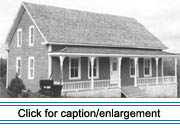|
 Constructed
in the mid-19th century, the Fred Albert House has many features of form
and construction that may be considered distinctively Maine Acadian. Its
architectural history and the histories of the residents illustrate many
of the elements of Maine Acadian heritage. Constructed
in the mid-19th century, the Fred Albert House has many features of form
and construction that may be considered distinctively Maine Acadian. Its
architectural history and the histories of the residents illustrate many
of the elements of Maine Acadian heritage.
Prior to being moved by the Madawaska Historical Society to its present
site behind the societyís Tante Blanche Museum, the Fred Albert House
stood in Madawaska, on St. John River Lot 138. Its architectural characteristics
suggest that Luke Albert (1818ñ1888) or his father, Anselme Albert, was
the builder. Last occupied in 1970, the house was dedicated as a museum
in 1990. Rev. Thomas Albert ([1920] 1985) lists the Albert family among
the south-shore pioneers of the Upper St. John River Valley. FranÁois
Albert, Jr. and his wife Marie Anne moved to the Madawaska territory from
Lower Canada. As early settlers they had an opportunity to choose their
land, and were able to secure property along a brook that had potential
as a mill site. The deed that transfers the property from FranÁois Albert,
Jr. to his son Anselme makes it clear that the family was living on Lot
138 by 1806.
The details of the deed of maintenance that was a provision of the 1806
transfer suggest that the family was fairly prosperous. Anselme was expected
to provide his parents annually with 25 pounds of good beef, 12 pounds
of butter or hogís lard, 12 pounds of tallow, 12 pounds of maple sugar,
half a pound of pepper, 1 bushel of salt, 3 gallons of rum, 5 pounds of
good tobacco, 1 suit of homespun clothes, 1 linen shirt, 1 flannel shirt,
5 pairs of shoe-pacs, 1 silk neck handkerchief, 1 pocket handkerchief,
and various other goods.
 The one-and-a-half-story Albert House has the typical Georgian proportions
and square-hewn log (piËce sur piËce) wall construction of other
19th-century houses described in this report. In the house, piËce sur
piËce ‡ tenons en coulisse wall construction is combined with half-dovetail
joinery at the corners. Such a combination of construction methods has
been documented at the Morissette House/Maison Morissette (circa 1830)
in QuÈbec (Lessard and VilandrÈ 1974: 395ñ409). However, the Morissette
House has a ridgepole, while the Albert House, like other houses of its
type in the Valley, is constructed without one. In addition, the house
in QuÈbec features two internal chimneys placed against the opposite external
walls of the house, while the Albert House appears to have had only a
central chimney. Like many other Upper St. John Valley houses of the mid-19th
century, the Albert House has shipís knees fitted into the attic.
The one-and-a-half-story Albert House has the typical Georgian proportions
and square-hewn log (piËce sur piËce) wall construction of other
19th-century houses described in this report. In the house, piËce sur
piËce ‡ tenons en coulisse wall construction is combined with half-dovetail
joinery at the corners. Such a combination of construction methods has
been documented at the Morissette House/Maison Morissette (circa 1830)
in QuÈbec (Lessard and VilandrÈ 1974: 395ñ409). However, the Morissette
House has a ridgepole, while the Albert House, like other houses of its
type in the Valley, is constructed without one. In addition, the house
in QuÈbec features two internal chimneys placed against the opposite external
walls of the house, while the Albert House appears to have had only a
central chimney. Like many other Upper St. John Valley houses of the mid-19th
century, the Albert House has shipís knees fitted into the attic.
|
 |

